The one Australian holiday we all must take
With international travel plans on hold, Australians are exploring their own backyard. This destination should be on everyone’s list.
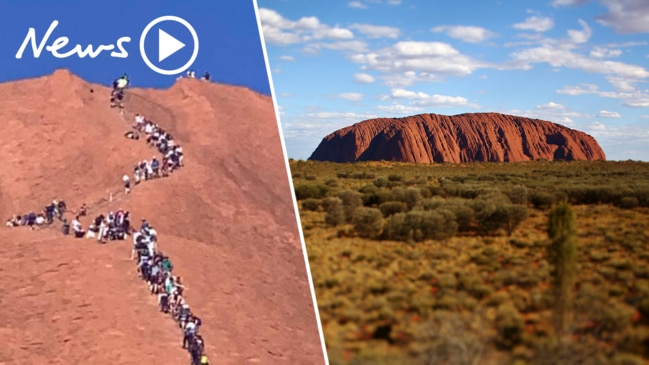
U on Sunday
Don't miss out on the headlines from U on Sunday. Followed categories will be added to My News.
I can feel it. Standing at its base, listening to the sound of the trees whispering in the hot wind of the desert, I’m looking up as it towers over me and it’s overwhelming. The power, the culture, the history, the stories, the significance and pure magic of this extraordinary destination.
Uluru, isn’t just a landmark to see (although it is undoubtedly impressive from every angle), it’s one you have to experience. And when you do, you will be lucky enough to feel, just as I did, the spirit and heart of Australia.
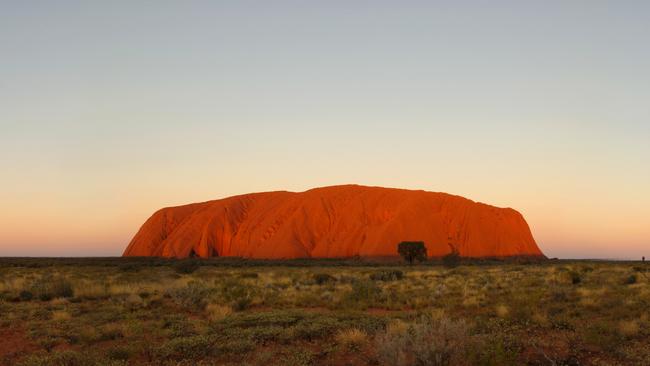
I thought I’d given my bucket list a good crack; seeing the Northern Lights in Swedish Lapland, snorkelling in Iceland between two tectonic plates, dog sledding in a village in the Arctic Circle and hot air ballooning over Egypt’s Valley of the Kings in the millennial-old city of Luxor, a place that shaped civilisation. I never thought to add the most obvious Australian landmark.
It wasn’t something I was chasing until I was standing there right in front of it.
This sandstone monolith in the Uluru-Kata Tjuta National Park is one of the greatest places I’ve ever been. The most beautiful, culturally powerful, significant, sacred and the most remote in Australia.
After a three-hour flight from Brisbane, across an impressive changing landscape, my husband and I land in Yulara, the township just outside the national park, in the Northern Territory.
Through the vast plains of red desert sand, we can see the rock in the distance and can’t wait to explore. But our first stop as the sun sets is the Field of Light. This impressive outdoor display by artist Bruce Munro has to be seen to be believed. As darkness falls, an enchanting vision appears as 50,000 coloured solar lights switch on. The bulbs, which change colour every 10 seconds or so, sit on the ends of stems with their formations making it feel like you’re in the middle of an electric field of flowers.
We wander through the exhibition, as large as seven football fields, and marvel at this masterpiece, Uluru in the background.
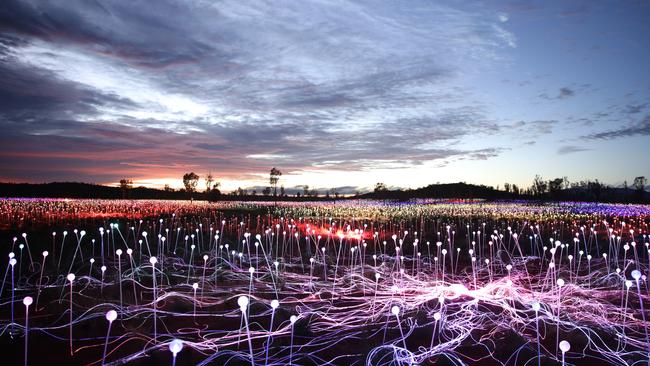
The next morning, we pick up our takeaway breakfast from Sails in the Desert, where we’re staying, and drive out to enjoy it watching sunrise over Uluru.
As the sun makes its way above the horizon, it sheds light over the vast plains, sparse trees, red sand and most spectacularly, it fills the rock with colour. It’s changing from purple to red and finally a fiery hue of orange and feels like we’re watching an artist at work.
We put down the cameras to truly appreciate what we’re seeing.
Then, it’s quickly onto the base walk while the sun is still warming up. It’s a perfect time, and only time on our visit last month, to be active before the burning heat of the Red Centre hits its peak of 40C. Unsurprisingly, outside the cooler months, you have no option but to get going early with Uluru and Kata Tjuta National Park rangers closing walking tracks at 11am when temperatures exceed 36C – as they do for most of the summer.
The Uluru base walk is 10km and experts say to allow 3½ hours to make your way around the simple, flat, dirt circuit track (although it took us two hours). There are shorter walks within Uluru but the full loop is easy to manage for all ages and fitness levels. If walking isn’t for you, you can join a Segway tour, but today we’re on foot and from down here, right underneath the rock, you can truly appreciate its majestic force.
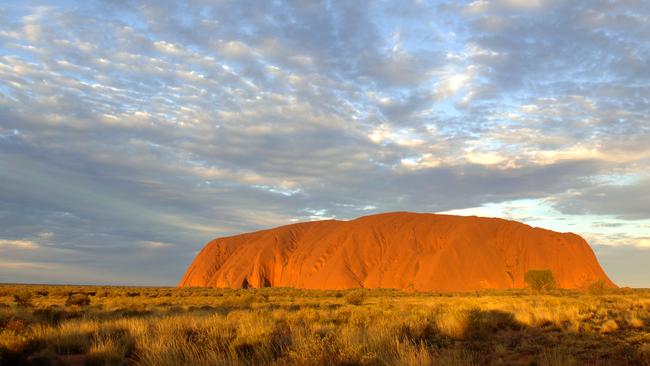
Uluru is 348m above the ground, higher than the Eiffel Tower in Paris, and its circumference is 9.4km. Its weight (for the rock above the ground) has been estimated to be more than 1425 million tonnes. With every step, the rock changes, there’s a new cave, crevice or waterfall after heavy rain. It’s more detailed, with more hidden stories, than I could have ever imagined.
We’re plugged into the audio guide, on headphones, hearing that behind the rock art, thousands of years old, caves were used as shelter, and traditional tales.
This enormous rock is stunning from every angle, near or far, but this walk will solidify its magic.
It’s a magic that can be felt long into the night with the Sounds of Silence dinner experience. Among the sand dunes, under the stars of a clear Australian outback sky, we’re dining in what has to be one of the most unique dinner settings in the world.
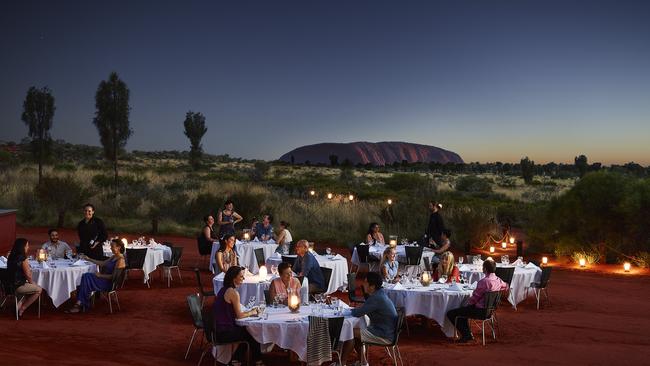
After a three-course meal and free flowing drinks, all lights are turned off and we’re given the chance to truly revel in the twinkling beauty above us. The night sky comes alive with a blanket of stars. Most of us city slickers live where there’s too much light pollution to ever see such a sight. But here on the sand dunes of the central Australian desert, the Milky Way is shining brightly.
An astronomer explains constellations and points out visible planets with a laser beam. There’s Jupiter, over there is Mars and just up there is Saturn.
The incredible scene is not lost on us as we nibble on our dessert, sip our drinks and admire what our country is capable of.
You don’t even have to travel oceans to get to Yulara, where you’ll find Uluru. Yulara is largely made up of Ayers Rock Resort, an Aboriginal-owned initiative with accommodation and restaurants. While there are some shops, art galleries and a day spa, the main attractions are the rock formations within the Uluru-Kata Tjuta National Park, with the entry a 10-minute drive away.
With the heat burning outside, we take a day to indulge in what the resort has to offer including a massage from the Red Ochre Day Spa and free activities such as the Bush Food Experience, Bush Yarns and Guided Garden Walks. Among the highlights was a didgeridoo workshop where we formed an even deeper appreciation for the instrument that soundtracks Australia.
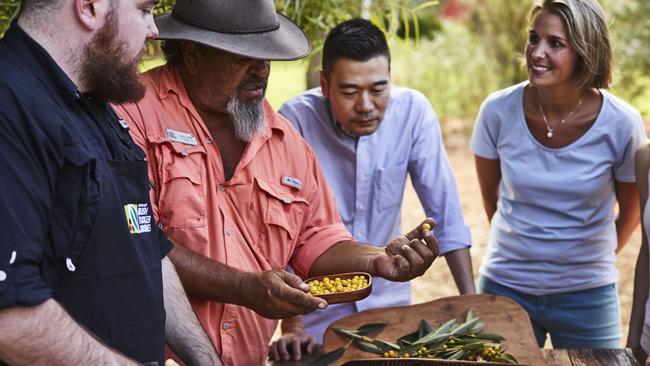
With the town still reeling from the pandemic, many restaurants and shops are closed, including The Cultural Centre within the national park which is home to an art gallery. But just near the didge workshop two indigenous women paint in the park. They’re selling their pieces to passers-by and the didge teacher smiles.
“They haven’t been here since March (the start of the pandemic), it’s nice to see them back,” he says.
Each piece has a story to tell, much like the landscape that surrounds us.
On our third day we’re ready to explore Kata Tjuta, the neighbouring rock formation in the national park about 45 minutes’ drive away from Uluru. They’re known as The Olgas in English and are a group of dome-shaped rocks, and among them is the Valley of the Winds walk.
It’s classed as Grade 4 and even though it’s only 7.4km, it’s challenging. Guides say allow four hours to complete and while it only took us half this time, it is tough.
Red boulders and scattered piles of rocks create an other-worldly feel. This is the closest I’ll get to walking on Mars.
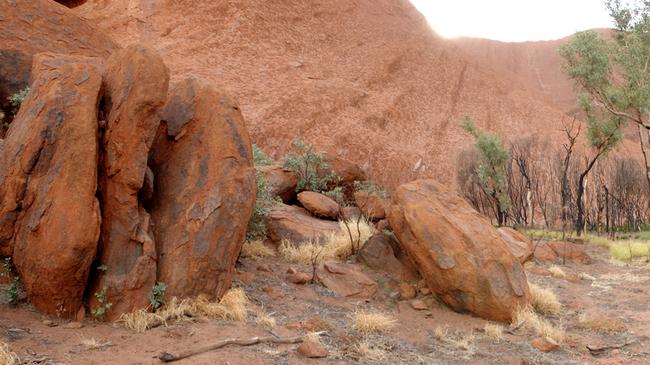
The ground is unsteady, you’re scaling small rock faces and it can be steep, it’s not to be taken on lightly. But there are options. You can walk to the first lookout, Karu lookout, which is 2.2km return and moderately difficult and turn back or, if you want the full experience, keep going onto Karingana lookout. The further you walk, the less crowds there are. At times, it feels like you have the valley to yourself.
The silence is broken only by the sound of the wind and, of course, the buzzing of the relentless flies. It would be wise to pack a fly net and keep it with you for such times. You look ridiculous but it’s a lifesaver.
For any walk in this area, where the heat is this fierce, it’s suggested to take water breaks every 15 minutes and drink a litre of water for every hour you’re walking. The only issue with this is there are no toilets near this walk, the facilities are only at the sunset viewing area.
With every step you take on this walk, you can feel the magic.
This site is culturally sensitive to the Anangu Aboriginal people. These rock formations hold knowledge and stories that can only be passed down by elders or cultural authorities in person on location to the right people at the right time.
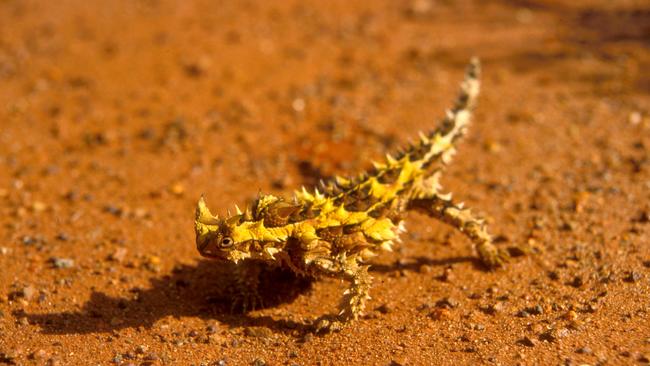
It’s for this reason it’s sacred and the Anangu ask no photos or videos be taken for commercial purposes. The official advice is you can take happy snaps but don’t upload them to social media.
The chance to put down your camera is refreshing. Stop. Take a deep breath and realise where you are. In pre-pandemic times, more than 250,000 visitors a year from across the world would be swarming these sites and perhaps even more after it was last month named in Lonely Planet’s top three best places to see in the world.
But with travel restrictions still in place, it’s the quietest it’s been in years. A blessing and a curse according to some locals. The town needs tourists to survive but many are secretly revelling in the fact they can feel the spirit of Uluru again. It took a pandemic for me to travel through my own country and it’s a place everyone should experience once in their lives.
The writer was a guest of Ayers Rock Resort



